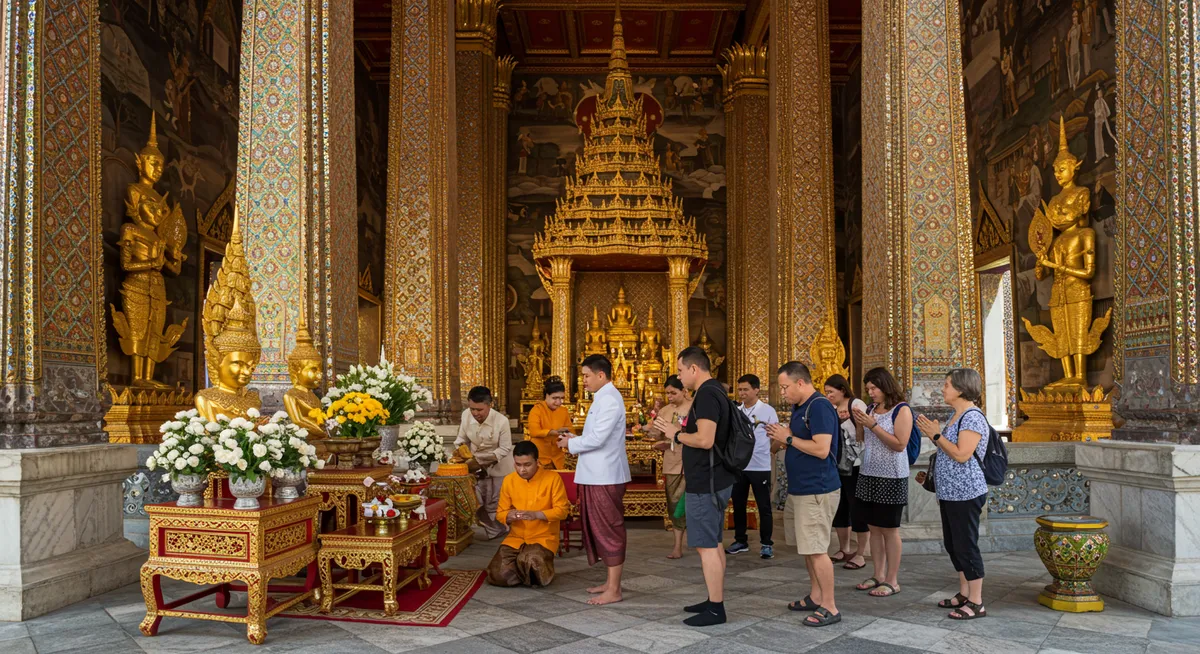
Mastering Bangkok Cultural Etiquette: Essential Tips
Table of Contents
Want to find the best travel deals for this destination? Chat with our travel hacking specialist!
Get Travel HacksCategory: bangkok-cultural-etiquette
Your Guide to Respectful Travel in Bangkok
As a seasoned traveler who’s explored the vibrant streets of Thailand countless times, I've learned that truly experiencing a destination means embracing its unique customs. Navigating Bangkok offers a sensory feast, but understanding a few key aspects of Bangkok cultural etiquette is paramount. It’s not just about avoiding faux pas; it's about showing genuine respect for the local way of life. By familiarizing yourself with Thai customs, you'll enrich your journey, foster warmer interactions, and leave a positive impression on the welcoming Thai people. This guide will equip you with the essential knowledge to confidently immerse yourself in the Land of Smiles.
Understanding Greetings and Gestures
When arriving in Thailand, one of the first things you'll encounter is the wai, the traditional Thai greeting. It involves pressing your palms together, fingers pointing upwards, at chest level, and bowing slightly. The higher your hands and the deeper the bow, the more respect is shown. Generally, elders and those in higher positions are greeted first. As a foreigner, you aren't expected to initiate the wai with everyone, but returning it is always appreciated and shows excellent Bangkok cultural etiquette. Remember that feet are considered the lowest and dirtiest part of the body, so never point them at people or religious objects. On one of my first trips, I quickly learned to always tuck my feet away when seated on the floor. This simple act goes a long way, especially during the best time to visit Bangkok, ensuring smooth interactions.
Dress Codes for Temples and Public Spaces
Visiting temples (wats) is a highlight for many travelers, offering deep insights into Thai spirituality. Adhering to the appropriate dress code is crucial when entering these sacred sites. Both men and women should ensure shoulders and knees are covered. This typically means wearing long trousers or skirts, and shirts with sleeves. I always recommend carrying a light scarf or sarong for impromptu temple visits. While everyday attire in bustling areas might be more casual, maintaining modest dress, especially in places of worship, reflects genuine respect for local traditions. For general travel tips, consider checking out this comprehensive Bangkok travel guide, perfect for understanding the local context.
Dining Etiquette and Social Norms
Thai cuisine is globally renowned, and sharing meals is central to Thai social life. When dining, sticky rice and main dishes are often shared family-style. Forks are typically used to push food onto a spoon for eating; food is rarely lifted directly to the mouth with a fork. Chopsticks are generally reserved for noodle dishes. It's polite to taste a little of everything and offer to share. Avoid putting your spoon or fork directly into shared bowls, use the serving utensils provided. My personal tip: always compliment the host on the food; it's a small gesture that brings great warmth and shows you appreciate their hospitality and the local Bangkok cultural etiquette. Understanding this also helps manage your Bangkok travel budget, as authentic dining can be very affordable.
Navigating Sacred Sites with Respect
Thailand is deeply Buddhist, and showing reverence in sacred spaces is paramount. When inside a temple, speak softly, remove your shoes before entering, and never touch Buddha images. Women should not directly touch monks; if you need to give something to a monk, place it on a cloth or ask a man to pass it. Always walk around a stupa or important religious structure in a clockwise direction. Photography is usually allowed, but avoid taking photos during prayer times or if it disrupts worshippers. Understanding these nuances contributes significantly to a harmonious visit, especially if you're planning how many days to spend in Bangkok exploring its rich heritage.
Frequently Asked Questions
Is it rude to bargain in Bangkok?
How should I address people in Thailand?
Can I wear my shoes inside a Thai home?
Embracing Bangkok cultural etiquette not only ensures a smoother, more enjoyable trip but also enriches your understanding of Thailand's profound heritage. By observing simple customs—like the proper wai, modest dress, and respectful behavior in sacred spaces—you demonstrate genuine appreciation for Thai culture. These small efforts build bridges, making your interactions with locals more meaningful. For a deeper dive into planning your entire adventure, don't forget to visit Plan Vacation Asia. Start practicing these tips today to transform your Bangkok visit into an unforgettable journey of discovery and respect.